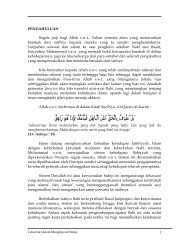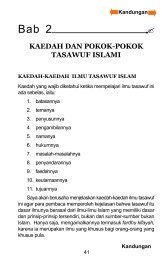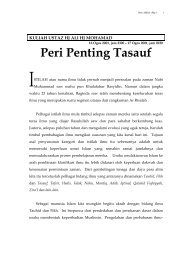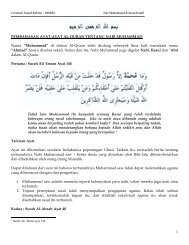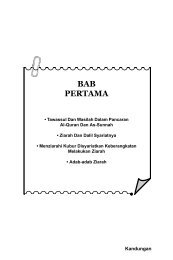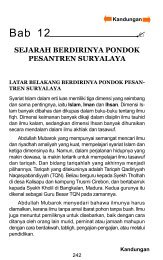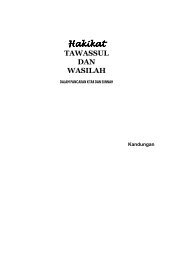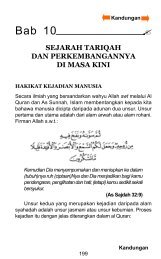inab3 cover front.psd - Khadijah Mosque
inab3 cover front.psd - Khadijah Mosque
inab3 cover front.psd - Khadijah Mosque
Create successful ePaper yourself
Turn your PDF publications into a flip-book with our unique Google optimized e-Paper software.
individuals recruited into Salafi or Muslim<br />
Brotherhood groups decide at some point<br />
that their mentors are not Islamic enough<br />
and move on to even more extreme and<br />
violent groups. This progression from<br />
religious radicalism to violent extremism is<br />
made possible by the absence of firewalls<br />
between mainstream Islam and radicals and<br />
violent extremists. Violent extremists can<br />
derive scriptural justifications for their<br />
actions. This is because the elements of the<br />
Islamic tradition that could be used to lend<br />
support to radical interpretations have not<br />
yet been anachronized. Therefore, if the goal<br />
is to turn the ideological tide, modernizing<br />
Islamic teachings on jihad is an area where<br />
progressive theological work is needed.<br />
1 Donald K. Emmerson, “Islam, Muslims,<br />
and Violence: The Useful Diversity of<br />
‘Islamism,’” Paper prepared for Special<br />
Session on “Islam and Political Violence,”<br />
Annual Convention of the Middle East<br />
Studies Association, November 20-23, 2004<br />
(draft).<br />
2 International Crisis Group (ICG), “Jemaah<br />
Islamiyah in Southeast Asia: Damaged but<br />
Still Dangerous,” ICG Asia Report No. 63,<br />
Jakarta/Brussels: August 26, 2003, p. 6.<br />
3 “Saudis Quietly Promote Strict Islam in<br />
Indonesia,” New York Times, July 5, 2003.<br />
4 Zachary Abuza, “Muslims, Politics, and<br />
Violence in Indonesia: An Emerging Jihadist-<br />
Islamist Nexus?” NBR Analysis, Vol. 15, No.<br />
3, September 2004, p. 31.<br />
Sources of the Radicalization of<br />
Muslim Communities<br />
in Southeast Asia<br />
Having defined radicalization and the<br />
issues associated with this process in general<br />
terms, we can turn to the Southeast Asian<br />
experience. One of the assumptions stated<br />
in the concept paper for this conference is<br />
that violent extremism and the radicalization<br />
of the Muslim communities are recent<br />
phenomena. This is true, for the reasons<br />
that I suggested at the beginning of this<br />
presentation, but there have been some<br />
historical deviations from the norm. As the<br />
Indonesian participants here know, the Padri<br />
movement in Sumatra in the 1820s and 1830s<br />
involved an effort to introduce Wahhabism,<br />
sometimes using forceful methods, by<br />
preachers who had returned from Mecca and<br />
had been influenced by Wahhabi teachings<br />
during the al-Sauds’ first occupation of the<br />
city at the beginning of the nineteenth<br />
century.<br />
With this exception, and of the uprisings<br />
against the colonial powers that combined<br />
ethnic and religious factors, the only major<br />
Islamist revolt in the modern history of<br />
Southeast Asia was the Darul Islam rebellion<br />
from 1949 to 1962. The Darul Islam experience<br />
is important because it is one of the<br />
fountainheads of the regional terrorist<br />
movement that goes by the name of Jemaah<br />
Islamiyah, which seems to me a<br />
misappropriation of a perfectly respectable<br />
name, but this precisely one of the tactics of<br />
the extremists, which is to cloak themselves<br />
in the language of religion.<br />
As Sidney Jones has pointed out in her<br />
analyses of the origins of Islamist terrorist<br />
in Indonesia, Abdullah Sungkar, the cofounder<br />
of Jemaah Islamiyah, served as an<br />
officer in Darul Islam leader Kartosuwirjo’s<br />
Islamic Army of Indonesia and Abu Bakar<br />
Ba’asyir, although he did not participate in<br />
the rebellion, accepted the Darul Islam’s<br />
ideological agenda.2 Individuals from<br />
families with a Darul Islam backgrounds<br />
continue to play an important role in<br />
terrorism in Indonesia. The point here is that<br />
while external factors provided the catalyst<br />
for radicalization and violent extremism in<br />
Southeast Asia, these phenomena have<br />
internal sources as well.<br />
Nevertheless, while the seeds of<br />
radicalization in Southeast Asia were already<br />
there, this process was catalyzed by the<br />
worldwide Islamic revival in its Salafi and<br />
Wahhabi manifestations there is nothing<br />
wrong with religious piety per se and by the<br />
influx of money and ideologies from the<br />
Middle East, which has allowed extremist<br />
groups to expand their activities and to make<br />
inroads Southeast Asian educational and<br />
social welfare networks.<br />
First, the effects of the worldwide Islamic<br />
resurgence. This is a complex phenomenon<br />
that reflects the stresses of traditional<br />
societies and of individuals within these<br />
societies as they seek to adjust to or cope<br />
66 Masjid <strong>Khadijah</strong>



